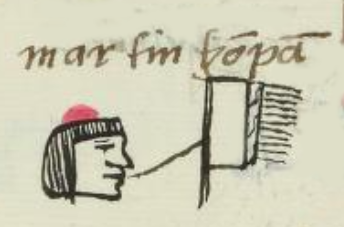Tzompan (MH876v)
This black-line drawing of the compound glyph for the personal name Tzompan ("Skull Rack," attested here as a man's name) shows an upright, white flag (panitl) facing toward the viewer's right. On the right margin of the flag is a border with hair (tzontli) blowing out horizontally from it. A similar margin for the hair (perhaps a tie with a design that is emblematic of the bundles of 400 things–also tzontli–such as blades of grass, sticks, or the like that were tied for presenting as tributes) appears on the Tzompan glyph from folio 652 verso of the Matrícula de Huexotzinco. The two phonetic indicators (tzom- and -pan) combine to produce the name Tzompan (from tzompantli, skull rack, stretching from hair to head to skull).
Stephanie Wood
In this collection there are a number of Tzompan name glyphs like this one, fully phonetic, as shown below. One Tzompan glyph is the tree that is an alternative reading of the term tzompantli, although that, too, could be a disguise for the real meaning relating to the skull rack. Finally, see the actual skull rack glyph from the Codex Mendoza below, too.
Stephanie Wood
martin tzōpā
Martín Tzompan
Stephanie Wood
1560
Jeff Haskett-Wood
cráneos, banderas, pelo, cabello, 400, flags, banners, sticks, palos, nombres de hombres

tzon(tli), human hair, https://nahuatl.wired-humanities.org/content/tzontli
pan(itl), flag, banner, https://nahuatl.wired-humanities.org/content/panitl
tzompan(tli), skull rack or tree, https://nahuatl.wired-humanities.org/content/tzompantli
Estante de Craneos
Stephanie Wood
Matrícula de Huexotzinco, folio 876v, World Digital Library, https://www.loc.gov/resource/gdcwdl.wdl_15282/?sp=825&st=image.
This manuscript is hosted by the Library of Congress and the World Digital Library; used here with the Creative Commons, “Attribution-NonCommercial-ShareAlike 3.0 License” (CC-BY-NC-SAq 3.0).






